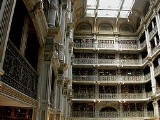
Peabody Institute Library
Encyclopedia
The George Peabody Library, formerly known as the Library of the Peabody Institute
, is the 19th century research library of The Johns Hopkins University
. It is located on the Peabody campus at Mount Vernon Place in Baltimore
, Maryland
. The collections are available for use by the general public, in keeping with the philanthropist George Peabody's goal to create a library "which is to be maintained for the free use of all persons who desire to consult it."
 The Peabody Institute Library was funded by the good graces of George Peabody
The Peabody Institute Library was funded by the good graces of George Peabody
. Peabody, having become a wealthy man in Baltimore through commerce, "gave $300,000 as a beginning sum for the Peabody Institute" in February 1857. Peabody dedicated the Institute to the citizens of Baltimore in appreciation of their kindness and hospitality. The Institute was designed to be a cultural center for Baltimore, with plans for an art gallery and music school, as well as a public library. The Peabody Institute opened in 1866 and the current library structure opened to the public in 1878. The library remained part of the Peabody Institute until 1967, when it was transferred to the City of Baltimore and became a department in the Enoch Pratt Free Library. In 1982 it was transferred to Johns Hopkins University and became part of the Eisenhower Library's Special Collections department.
interior features an atrium that, over a black and white marble floor, soars 61 feet to a latticed skylight surrounded by five tiers of ornamental cast-iron balconies and gold-scalloped columns. Between July 2002 and May 2004, the library underwent a $1 million renovation and was refurbished.
Peabody Institute
The Peabody Institute of the Johns Hopkins University is a renowned conservatory and preparatory school located in the Mount Vernon neighborhood of Baltimore, Maryland at the corner of Charles and Monument Streets at Mount Vernon Place.-History:...
, is the 19th century research library of The Johns Hopkins University
Johns Hopkins University
The Johns Hopkins University, commonly referred to as Johns Hopkins, JHU, or simply Hopkins, is a private research university based in Baltimore, Maryland, United States...
. It is located on the Peabody campus at Mount Vernon Place in Baltimore
Baltimore
Baltimore is the largest independent city in the United States and the largest city and cultural center of the US state of Maryland. The city is located in central Maryland along the tidal portion of the Patapsco River, an arm of the Chesapeake Bay. Baltimore is sometimes referred to as Baltimore...
, Maryland
Maryland
Maryland is a U.S. state located in the Mid Atlantic region of the United States, bordering Virginia, West Virginia, and the District of Columbia to its south and west; Pennsylvania to its north; and Delaware to its east...
. The collections are available for use by the general public, in keeping with the philanthropist George Peabody's goal to create a library "which is to be maintained for the free use of all persons who desire to consult it."
History

George Peabody
George Peabody was an American-British entrepreneur and philanthropist who founded the Peabody Trust in Britain and the Peabody Institute in Baltimore, and was responsible for many other charitable initiatives.-Biography:...
. Peabody, having become a wealthy man in Baltimore through commerce, "gave $300,000 as a beginning sum for the Peabody Institute" in February 1857. Peabody dedicated the Institute to the citizens of Baltimore in appreciation of their kindness and hospitality. The Institute was designed to be a cultural center for Baltimore, with plans for an art gallery and music school, as well as a public library. The Peabody Institute opened in 1866 and the current library structure opened to the public in 1878. The library remained part of the Peabody Institute until 1967, when it was transferred to the City of Baltimore and became a department in the Enoch Pratt Free Library. In 1982 it was transferred to Johns Hopkins University and became part of the Eisenhower Library's Special Collections department.
Collection
The main collection reflects scholarly interests and fads of the 19th century. The library's 300,000 volume collection is particularly strong in religion, British art, architecture, topography and history; American history, biography, and literature; Romance languages and literature; history of science; and geography, exploration and travel. While the majority of titles date to the 19th century, the library also has a strong assortment of early printed books, cuneiform tablets, and a marquee collection of Don Quixote editions.Building
The library is one of the most beautiful in the United States. Completed in 1878, it was designed by Baltimore architect Edmund G. Lind in collaboration with the first Peabody provost, Nathaniel H. Morison, that described it as a "cathedral of books." The neo-GrecNeo-Grec
Neo-Grec is a term referring to late manifestations of Neoclassicism, early Neo-Renaissance now called the Greek Revival style, which was popularized in architecture, the decorative arts, and in painting during France's Second Empire, or the reign of Napoleon III, a period that lasted...
interior features an atrium that, over a black and white marble floor, soars 61 feet to a latticed skylight surrounded by five tiers of ornamental cast-iron balconies and gold-scalloped columns. Between July 2002 and May 2004, the library underwent a $1 million renovation and was refurbished.
External links
- George Peabody Library Research Guide - Official Site for The George Peabody Library
- Collection Highlights - Flickr Album for The George Peabody Library
- Peabody Wunderkammer- Official Tumblr for the George Peabody Library

